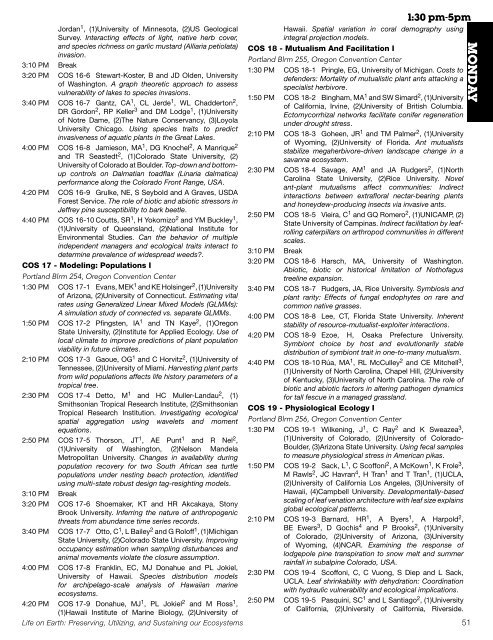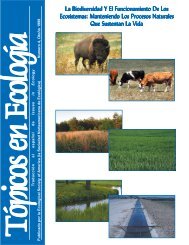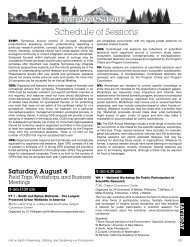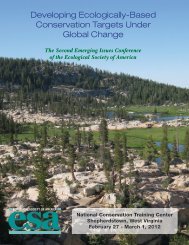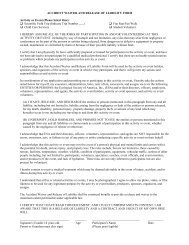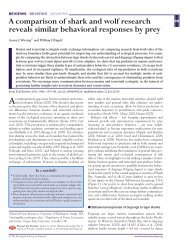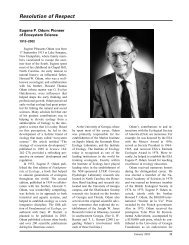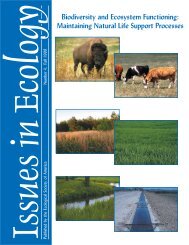Printed Program (PDF) - Ecological Society of America
Printed Program (PDF) - Ecological Society of America
Printed Program (PDF) - Ecological Society of America
You also want an ePaper? Increase the reach of your titles
YUMPU automatically turns print PDFs into web optimized ePapers that Google loves.
Jordan<br />
Life on Earth: Preserving, Utilizing, and Sustaining our Ecosystems<br />
1 3:10 PM<br />
, (1)University <strong>of</strong> Minnesota, (2)US Geological<br />
Survey. Interacting effects <strong>of</strong> light, native herb cover,<br />
and species richness on garlic mustard (Alliaria petiolata)<br />
invasion.<br />
Break<br />
3:20 PM COS 16-6 Stewart-Koster, B and JD Olden, University<br />
<strong>of</strong> Washington. A graph theoretic approach to assess<br />
vulnerability <strong>of</strong> lakes to species invasions.<br />
3:40 PM COS 16-7 Gantz, CA1 , CL Jerde1 , WL Chadderton2 ,<br />
DR Gordon2 , RP Keller3 and DM Lodge1 , (1)University<br />
<strong>of</strong> Notre Dame, (2)The Nature Conservancy, (3)Loyola<br />
University Chicago. Using species traits to predict<br />
invasiveness <strong>of</strong> aquatic plants in the Great Lakes.<br />
4:00 PM COS 16-8 Jamieson, MA1 , DG Knochel2 , A Manrique2 and TR Seastedt2 , (1)Colorado State University, (2)<br />
University <strong>of</strong> Colorado at Boulder. Top-down and bottomup<br />
controls on Dalmatian toadflax (Linaria dalmatica)<br />
performance along the Colorado Front Range, USA.<br />
4:20 PM COS 16-9 Grulke, NE, S Seybold and A Graves, USDA<br />
Forest Service. The role <strong>of</strong> biotic and abiotic stressors in<br />
Jeffrey pine susceptibility to bark beetle.<br />
4:40 PM COS 16-10 Coutts, SR1 , H Yokomizo2 and YM Buckley1 ,<br />
(1)University <strong>of</strong> Queensland, (2)National Institute for<br />
Environmental Studies. Can the behavior <strong>of</strong> multiple<br />
independent managers and ecological traits interact to<br />
determine prevalence <strong>of</strong> widespread weeds?.<br />
COS 17 - Modeling: Populations I<br />
Portland Blrm 254, Oregon Convention Center<br />
1:30 PM COS 17-1 Evans, MEK1 and KE Holsinger2 , (1)University<br />
<strong>of</strong> Arizona, (2)University <strong>of</strong> Connecticut. Estimating vital<br />
rates using Generalized Linear Mixed Models (GLMMs):<br />
A simulation study <strong>of</strong> connected vs. separate GLMMs.<br />
1:50 PM COS 17-2 Pfingsten, IA1 and TN Kaye2 , (1)Oregon<br />
State University, (2)Institute for Applied Ecology. Use <strong>of</strong><br />
local climate to improve predictions <strong>of</strong> plant population<br />
viability in future climates.<br />
2:10 PM COS 17-3 Gaoue, OG1 and C Horvitz2 , (1)University <strong>of</strong><br />
Tennessee, (2)University <strong>of</strong> Miami. Harvesting plant parts<br />
from wild populations affects life history parameters <strong>of</strong> a<br />
tropical tree.<br />
2:30 PM COS 17-4 Detto, M1 and HC Muller-Landau2 , (1)<br />
Smithsonian Tropical Research Institute, (2)Smithsonian<br />
Tropical Research Institution. Investigating ecological<br />
spatial aggregation using wavelets and moment<br />
2:50 PM<br />
equations.<br />
COS 17-5 Thorson, JT1 , AE Punt1 and R Nel2 ,<br />
(1)University <strong>of</strong> Washington, (2)Nelson Mandela<br />
3:10 PM<br />
Metropolitan University. Changes in availability during<br />
population recovery for two South African sea turtle<br />
populations under nesting beach protection, identified<br />
using multi-state robust design tag-resighting models.<br />
Break<br />
3:20 PM COS 17-6 Shoemaker, KT and HR Akcakaya, Stony<br />
Brook University. Inferring the nature <strong>of</strong> anthropogenic<br />
threats from abundance time series records.<br />
3:40 PM COS 17-7 Otto, C1 , L Bailey2 and G Rol<strong>of</strong>f1 , (1)Michigan<br />
State University, (2)Colorado State University. Improving<br />
occupancy estimation when sampling disturbances and<br />
animal movements violate the closure assumption.<br />
4:00 PM COS 17-8 Franklin, EC, MJ Donahue and PL Jokiel,<br />
University <strong>of</strong> Hawaii. Species distribution models<br />
for archipelago-scale analysis <strong>of</strong> Hawaiian marine<br />
ecosystems.<br />
4:20 PM COS 17-9 Donahue, MJ1 , PL Jokiel2 and M Ross1 ,<br />
(1)Hawaii Institute <strong>of</strong> Marine Biology, (2)University <strong>of</strong><br />
1:30 pm-5pm<br />
Hawaii. Spatial variation in coral demography using<br />
integral projection models.<br />
COS 18 - Mutualism And Facilitation I<br />
Portland Blrm 255, Oregon Convention Center<br />
1:30 PM COS 18-1 Pringle, EG, University <strong>of</strong> Michigan. Costs to<br />
defenders: Mortality <strong>of</strong> mutualistic plant ants attacking a<br />
specialist herbivore.<br />
1:50 PM COS 18-2 Bingham, MA1 and SW Simard2 , (1)University<br />
<strong>of</strong> California, Irvine, (2)University <strong>of</strong> British Columbia.<br />
Ectomycorrhizal networks facilitate conifer regeneration<br />
under drought stress.<br />
2:10 PM COS 18-3 Goheen, JR1 and TM Palmer2 , (1)University<br />
<strong>of</strong> Wyoming, (2)University <strong>of</strong> Florida. Ant mutualists<br />
stabilize megaherbivore-driven landscape change in a<br />
savanna ecosystem.<br />
2:30 PM COS 18-4 Savage, AM1 and JA Rudgers2 , (1)North<br />
Carolina State University, (2)Rice University. Novel<br />
ant-plant mutualisms affect communities: Indirect<br />
2:50 PM<br />
interactions between extrafloral nectar-bearing plants<br />
and honeydew-producing insects via invasive ants.<br />
COS 18-5 Vieira, C1 and GQ Romero2 , (1)UNICAMP, (2)<br />
State University <strong>of</strong> Campinas. Indirect facilitation by leafrolling<br />
caterpillars on arthropod communities in different<br />
scales.<br />
3:10 PM Break<br />
3:20 PM COS 18-6 Harsch, MA, University <strong>of</strong> Washington.<br />
Abiotic, biotic or historical limitation <strong>of</strong> Noth<strong>of</strong>agus<br />
treeline expansion.<br />
3:40 PM COS 18-7 Rudgers, JA, Rice University. Symbiosis and<br />
plant rarity: Effects <strong>of</strong> fungal endophytes on rare and<br />
common native grasses.<br />
4:00 PM COS 18-8 Lee, CT, Florida State University. Inherent<br />
stability <strong>of</strong> resource-mutualist-exploiter interactions.<br />
4:20 PM COS 18-9 Ezoe, H, Osaka Prefecture University.<br />
4:40 PM<br />
Symbiont choice by host and evolutionarily stable<br />
distribution <strong>of</strong> symbiont trait in one-to-many mutualism.<br />
COS 18-10 Rúa, MA1 , RL McCulley2 and CE Mitchell3 ,<br />
(1)University <strong>of</strong> North Carolina, Chapel Hill, (2)University<br />
<strong>of</strong> Kentucky, (3)University <strong>of</strong> North Carolina. The role <strong>of</strong><br />
biotic and abiotic factors in altering pathogen dynamics<br />
for tall fescue in a managed grassland.<br />
COS 19 - Physiological Ecology I<br />
Portland Blrm 256, Oregon Convention Center<br />
1:30 PM COS 19-1 Wilkening, J1 , C Ray2 and K Sweazea3 ,<br />
(1)University <strong>of</strong> Colorado, (2)University <strong>of</strong> Colorado-<br />
Boulder, (3)Arizona State University. Using fecal samples<br />
to measure physiological stress in <strong>America</strong>n pikas.<br />
1:50 PM COS 19-2 Sack, L1 , C Sc<strong>of</strong>foni2 , A McKown1 , K Frole3 ,<br />
M Rawls2 , JC Havran4 , H Tran1 and T Tran1 , (1)UCLA,<br />
(2)University <strong>of</strong> California Los Angeles, (3)University <strong>of</strong><br />
Hawaii, (4)Campbell University. Developmentally-based<br />
scaling <strong>of</strong> leaf venation architecture with leaf size explains<br />
global ecological patterns.<br />
2:10 PM COS 19-3 Barnard, HR1 , A Byers1 , A Harpold2 ,<br />
BE Ewers3 , D Gochis4 and P Brooks2 , (1)University<br />
<strong>of</strong> Colorado, (2)University <strong>of</strong> Arizona, (3)University<br />
<strong>of</strong> Wyoming, (4)NCAR. Examining the response <strong>of</strong><br />
lodgepole pine transpiration to snow melt and summer<br />
rainfall in subalpine Colorado, USA.<br />
2:30 PM COS 19-4 Sc<strong>of</strong>foni, C, C Vuong, S Diep and L Sack,<br />
UCLA. Leaf shrinkability with dehydration: Coordination<br />
with hydraulic vulnerability and ecological implications.<br />
2:50 PM COS 19-5 Pasquini, SC1 and L Santiago2 , (1)University<br />
<strong>of</strong> California, (2)University <strong>of</strong> California, Riverside.<br />
MONDAY<br />
51


